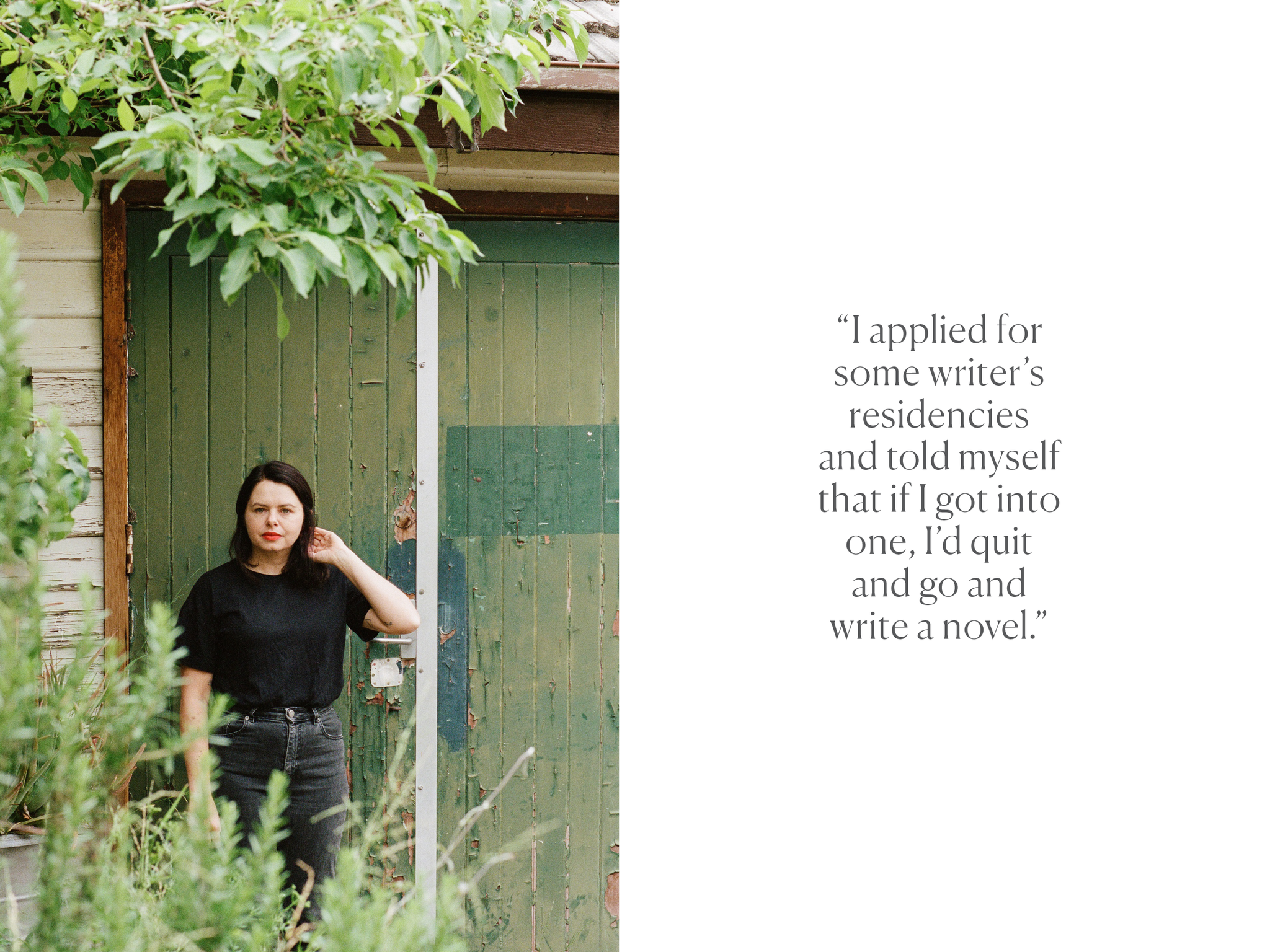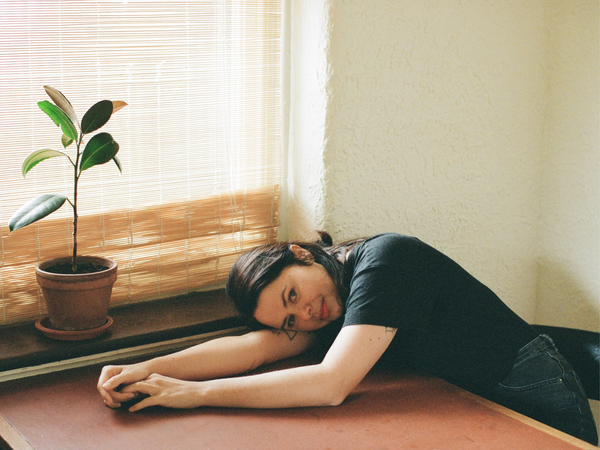Winner of the Victorian Premier’s Literary Award for an Unpublished Manuscript, Kokomo is the debut novel from Melbourne-based Photographer, Writer and Creative Director Victoria Hannan, who worked on the book during residencies in Brazil, Iceland, Tasmania and her home state of Victoria. We chat with Victoria about the key themes explored in the novel, her greatest influences and her new project.

Photography: Elize Strydom
It was while working at a miserable job that Victoria first conceptualised Kokomo. “I applied for some writer’s residencies and told myself that if I got into one, I’d quit and go and write a novel.” She did and found herself on the island of Ilhabela off the coast of Brazil. Sitting at her desk with a view of banana palms and baby toucans she wrote the first draft in a month. After that, she took breaks between freelance jobs and wrote the second and third drafts at residencies in Tasmania and Iceland. In September 2018, Victoria entered a draft into the Award for an Unpublished Manuscript at the VPLAs which, much to her absolute surprise, ended up winning. By April 2019, she had signed with an agent and had a two-book deal with Hachette.
Affectionately named after the 1988 Beach Boys’ song, Hannan uses the word ‘Kokomo’ to represent things we think are true or real but aren’t. “A friend sang it at a karaoke party and I became obsessed with the fact that the Kokomo the Beach Boys sang about doesn’t really exist. Other than a few resorts that have popped up since the song came out, the only real place named Kokomo is in Indiana and it’s a long way from an idyllic tropical paradise.”
The novel tells the story of a daughter (Mina) and her mother (Elaine). We enter their lives when Mina is living in London working in an advertising agency and has just received a phone call to tell her that her homebound mother back in Melbourne has left the family house for the first time in 12 years. Mina immediately boards a flight back to Australia, and from there the novel simmers with the specific kind of suffocation one can feel when returning to the domestic settings of childhood. Mother and daughter are once again living in the same house, as fascinating as strangers to one another. Occasionally they eat together (cups of tea are made, an unexpected and elaborate dinner of tagine is prepared) but for the majority of the novel, they are both performers of a sort of domestic dance of avoidance, unwilling to confront their own truths until forced to.

Photography: Elize Strydom
Much like her main character, Victoria lived in the UK for a long time working in a creative role at an ad agency. “I think like anyone who is lucky enough to have freedom of movement and chooses to live overseas, I often wondered if I was going to get a phone call in the middle of the night telling me I had to come home. My homecoming ended up being less dramatic than that but I definitely shared some of Mina’s feelings of grief for a life left behind and her feeling of disconnection with her family, friends and old life back in Melbourne.”
Using flashbacks and shifting perspectives, Kokomo moves across time and place with relative ease. The novel opens with scenes of Mina’s life in London, but the chapters mostly take place amongst the red-brick facades and hot concrete steps of Melbourne’s inner suburbs, which Hannan describes with affectionate attention. “Mina cut down the alley between the two red-brick walls. Up ahead, the creek bubbled, swollen just over its banks and gushing south. She followed the flow along the path lined with tall-trunked eucalyptus trees and fuzzy yellow wattle flowers dancing in the breeze.”
In Kokomo, a mirror is held up to a millennial experience. There is endless scrolling through a stressful social media landscape, disenchantment with careers and a generous serving of existentialism from cover to cover. Hannan’s writing is expressive and clever, observations of outer worlds in the novel often reflect the character’s inner lives. “A new delivery, an offering of sympathy on the doorstep, caught her eye. Daisies, their long white petals wilting in the heat. Mina picked them up, inhaled the bitter scent of their bright yellow middles, tiny dying suns.”

Photography: Elize Strydom
There is a gentle and persistent inquiry throughout the book into the complexities of love. Mostly romantic love, but also the familial, neighbourly kind. The joy of life-long friendships and open dialogue between characters is often undercut by the burden of the ideas and emotions they keep too close to the chest. By novel’s end, some secrets are still uncomfortably held, but there is more compassion and understanding. For both Mina and Elaine, space has been made for a new way forward, and however arduous it may be, that is enough to celebrate.
Launching the novel in the midst of a global pandemic required Victoria to adapt to a new way of working and living. “I keep reminding myself that it’s really only my experience of launching and touring the book that’s different. For most readers, their experience of buying and reading it is exactly the same. That’s been very grounding. When I’m not doing publicity for the book, I spend time weeding my vegetable garden. I cook a lot and try to read. I adopted a cat in May and so I lose hours every day taking photos of him sleeping and watching him run around the garden. I also watched all three seasons of Selling Sunset in a few days and then spent weeks on Zillow looking at beautiful houses in LA. Lockdown is a wild ride.”
When it comes to her greatest influences, Victoria credits authors Ann Patchett, Lorrie Moore, Ocean Vuong, Elizabeth Strout and Maggie Nelson as the authors who have made the biggest impact on her work. “Ann Patchett is a master of plot and I particularly love Commonwealth for its layers and flashbacks. I love Lorrie Moore’s short stories, especially Terrible Mother. Ocean Vuong’s prose makes me weep, it’s so beautiful and On Earth We’re Briefly Gorgeous makes me furious at how good it is. I love how Elizabeth Strout’s characters are both very sympathetic and unsympathetic, especially Olive Kitteridge. Maggie Nelson’s Bluets and the Red Parts have taught me a lot about vulnerability.”

Beyond Kokomo, Victoria writes an interesting newsletter named ‘Eyes as wide as swimming pools’. Each edition features one pool as the entry point for a short essay about something that was going on in her life at the time she swam in it. “I have always loved to swim but I think my obsession with swimming pools really took hold in 2011. I was working on the Speedo account and spent a lot of time researching, writing and creating content about swimming. I read a lot about the world’s most beautiful pools and decided I was going to try and swim in some of them.” She tells us when discussing the inspiration behind the project.
She also shares a passion for film photography. Shooting in 35mm, her work is mostly observational, although she has worked with a selection of brands on lookbooks and editorial. “I heard the writer George Saunders on a podcast last year and he said – and I’m paraphrasing here – that there’s as much beauty in a modern shopping centre as there was in Shakespeare’s London and that it’s the writer’s job to find it. That’s how I feel about both my writing and my photography. I try to find beauty where many people don’t think to look” she muses.
Victoria is currently working on the third draft of her second novel ‘Marshmallow’ a story set to explore how privilege affects how we recover from trauma.
To learn more about Victoria, follow her here:
@victorialhannan
